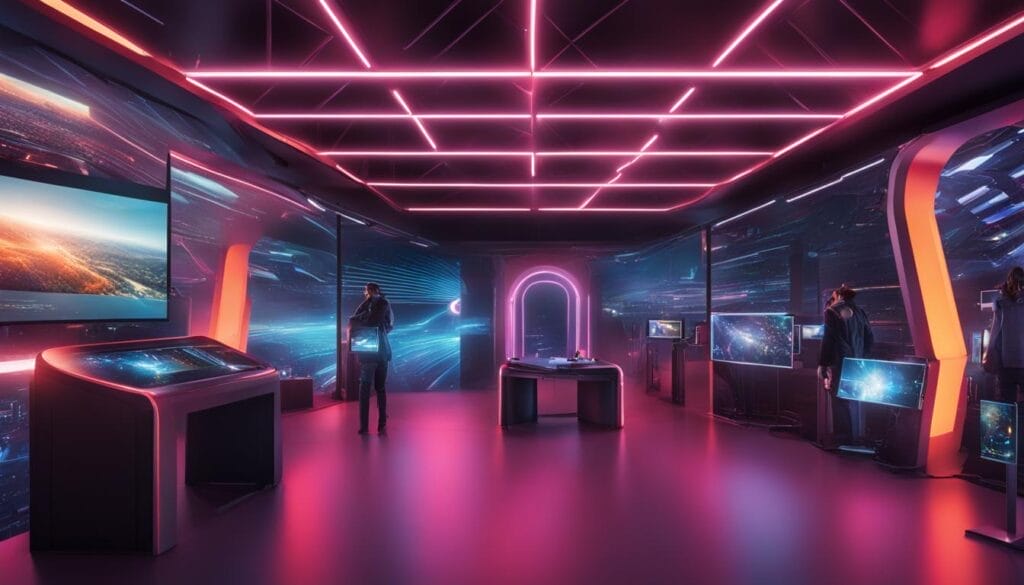The metaverse is revolutionizing the event industry, offering immersive and interactive experiences that transport attendees into virtual 3D worlds. To fully embrace the potential of metaverse events, it is essential to understand the technology requirements and equipment needed. From virtual event tech to creating immersive event experiences, this article will explore the key elements necessary for hosting or attending metaverse events.
Key Takeaways:
- Metaverse events rely on cutting-edge technology to create immersive and interactive experiences.
- Virtual event tech is crucial for hosting successful metaverse events.
- Immersive event experiences are made possible through augmented reality (AR) and virtual reality (VR) technologies.
- Understanding the hardware requirements and selecting the right equipment is essential for a seamless metaverse event experience.
- By embracing metaverse events, organizations can tap into a new realm of engagement and reach a global audience.
Understanding the Metaverse
The metaverse is a revolutionary concept that merges augmented reality (AR) and virtual reality (VR) to create an immersive and interactive digital realm. It represents a post-reality cosmos where physical and virtual worlds coexist, allowing users to explore, interact, and engage with digital products, environments, and other users. The metaverse has gained significant popularity in recent years, driven by advancements in technologies like VR headsets and the rebranding of Facebook to Meta.
With the metaverse, augmented reality events and virtual reality events take on a whole new level of possibilities. Attendees can experience events in a digital space that blurs the line between real and virtual, resulting in unique and engaging experiences. Augmented reality events create an overlay of digital content onto the physical world, enhancing the perception and interaction with the surroundings. Virtual reality events, on the other hand, transport participants into fully immersive and computer-generated environments, enabling a sense of presence and interaction with the virtual world.
AR and VR technologies are at the core of the metaverse, offering a seamless integration of physical and digital realities. The metaverse provides a networked web of immersive and sociable multiuser platforms, enabling users to transcend their physical limitations and connect with others in ways never before possible.
As the metaverse continues to evolve and expand, it opens up new possibilities for various industries, including entertainment, gaming, education, and even business. From attending virtual conferences and trade shows to exploring virtual art galleries and shopping in virtual stores, the metaverse offers a wide range of applications that can transform how we experience events and engage with digital content.
In the next section, we will delve deeper into the seven layers that make up the metaverse, each playing a crucial role in shaping the user experience and enabling the seamless integration of physical and digital realities.
The Seven Layers of the Metaverse

The metaverse, with its immersive and interactive nature, is built upon a complex structure of seven distinct layers, each contributing to the overall user experience. Understanding these layers is crucial for comprehending the metaverse’s value chain and the technologies that power it. Let’s delve into each layer in detail:
1. Experience
The experience layer forms the foundation of the metaverse, encompassing the sensory elements that engage users. It includes visual and audio elements, haptic feedback, and real-time interactions. This layer ensures users feel immersed and engaged within the virtual environment.
2. Discovery
The discovery layer focuses on helping users navigate and explore the metaverse. It includes search algorithms, recommendation systems, and personalized content delivery. This layer enables users to find new experiences, connect with communities, and discover relevant content within the vast metaverse.
3. Creator Economy
The creator economy layer empowers individuals and businesses to contribute to and monetize the metaverse. It includes tools and platforms for content creation, in-world commerce, and intellectual property rights management. This layer supports a thriving ecosystem of creators, enabling them to unleash their imagination and monetize their creations.
4. Spatial Computing
The spatial computing layer involves the technology that enables the metaverse to understand and interpret the physical world. It includes spatial mapping, object recognition, and real-time tracking. This layer facilitates the seamless integration of virtual elements with the real world, enhancing user experiences and enabling practical applications.
5. Decentralization
The decentralization layer focuses on ensuring the metaverse is governed by open protocols and distributed systems. It includes blockchain technology, decentralized identity, and peer-to-peer networking. This layer promotes autonomy, security, and ownership for users, fostering a more inclusive and transparent ecosystem.
6. Human Interface
The human interface layer encompasses the interfaces that enable users to interact with the metaverse. It includes hardware devices such as virtual reality headsets, augmented reality glasses, and haptic controllers. This layer plays a vital role in bridging the gap between the physical and virtual worlds, enhancing immersion and enabling intuitive interactions.
7. Infrastructure
The infrastructure layer provides the underlying technological backbone that supports the metaverse’s functionality. It includes cloud computing, edge computing, data centers, and high-speed internet networks. This layer ensures the metaverse can scale, handle massive data loads, and deliver seamless experiences to millions of users simultaneously.
These seven layers work together to create a comprehensive metaverse experience, unleashing a world of possibilities for entertainment, education, commerce, and beyond.
Key Features of the Metaverse

The metaverse offers several key features that have gained popularity in recent years. One of these features is the ability to create digital avatars, allowing users to fully immerse themselves in the virtual environment. These avatars can be customized to reflect one’s unique identity and provide a sense of presence and interaction within the metaverse. Whether it’s attending virtual meetings, socializing with friends, or exploring virtual worlds, digital avatars play a vital role in enhancing the metaverse experience.
Decentralization is another important feature of the metaverse. Unlike traditional online platforms, the metaverse is built on blockchain technology, which allows for ownership and control of virtual assets. Decentralization empowers users to have full control over their virtual possessions, such as digital art, virtual real estate, or even virtual currency. This feature gives users the freedom to engage in peer-to-peer transactions and eliminates the need for intermediaries, providing a more secure and transparent virtual environment.
Remote working has become increasingly prevalent in today’s digital age, and the metaverse offers unique opportunities to enhance this experience. With the ability to create virtual office spaces, collaborate with colleagues in real-time, and access productivity tools within the metaverse, remote workers can enjoy a more immersive and interactive work environment. The metaverse enables seamless communication and collaboration, bridging the gap between physical distance and facilitating remote work on a whole new level.
Security is a critical aspect of the metaverse, ensuring that users can safely interact and transact within virtual environments. With the rise of cyber threats and privacy concerns, robust security measures are essential to protect users’ personal information and digital assets. The metaverse employs advanced encryption techniques, identity verification protocols, and secure transaction mechanisms to safeguard user data and provide a safe and trustworthy virtual space for users to explore, interact, and conduct business.
Overall, the metaverse offers a range of key features that have transformed the way we experience and engage with digital environments. From digital avatars and decentralization to remote working and security, these features contribute to a more immersive, interactive, and secure metaverse experience. As technology continues to advance, the metaverse will undoubtedly evolve, offering even more exciting possibilities for users to explore and redefine the future of digital interactions.
Hardware Requirements for the Metaverse
To fully experience the metaverse, certain hardware is necessary. While basic requirements include a smartphone or tablet, a more immersive experience calls for a powerful laptop or desktop computer with a competent graphics card and a fast processor. Additionally, noise-cancelling headphones with an integrated microphone can enhance audio immersion. These hardware requirements are essential for hosting and participating in virtual events, including virtual event production and hybrid event solutions.
Table:
| Hardware | Minimum Requirements | Recommended Requirements |
|---|---|---|
| Smartphone/Tablet | – | – |
| Laptop/Desktop | – | Powerful graphics card, fast processor |
| Noise-Cancelling Headphones | – | Integrated microphone |
When it comes to virtual event production, having the right hardware is crucial for delivering a seamless and immersive experience to attendees. A powerful computer ensures smooth rendering of 3D visuals, while a fast processor enables real-time interactivity. These technological capabilities contribute to the overall success of virtual events by engaging participants and providing them with a sense of presence in the metaverse.
Hybrid event solutions, which combine physical and virtual elements, also require specific hardware to enable seamless integration and interaction between the two realms. This includes devices that can capture and stream live video, as well as provide synchronized audio and visual experiences for both in-person and virtual attendees. The use of advanced hardware enhances the production value of hybrid events and creates a dynamic and engaging experience for all participants.
Overall, investing in the right hardware is essential for unlocking the full potential of the metaverse. Whether it’s for hosting virtual events, producing immersive experiences, or facilitating hybrid gatherings, having the recommended hardware ensures a smooth and impactful metaverse experience for all involved.
Steps to Host an Event in the Metaverse
Hosting an event in the metaverse requires careful planning and utilization of the right tools and platforms. By following a series of steps, event organizers can ensure a successful and engaging experience for their attendees. Here are the key steps to host an event in the metaverse:
1. Define the event concept and goals
Before diving into the logistics of hosting a metaverse event, it is crucial to clearly define the concept and goals of the event. Determine the purpose of the event, whether it is a conference, social gathering, or product launch. This will help guide all subsequent decisions and ensure that the event aligns with its intended objectives.
2. Select the right platform
Choosing the appropriate virtual conference platform is essential for a seamless event experience. Look for platforms that offer features such as customizable virtual spaces, interactive tools, and networking capabilities. Consider factors like scalability, user-friendliness, and the ability to cater to the desired number of attendees. Research and demo different platforms to find the one that best fits the event requirements.
3. Create engaging content
Engaging content is key to capturing and maintaining attendees’ interest throughout the event. Develop a content strategy that includes presentations, panel discussions, interactive workshops, and networking opportunities. Leverage the capabilities of the metaverse to provide unique and immersive experiences for participants, such as virtual reality demos or augmented reality product showcases.
4. Execute the event in a virtual setting
Once all the preparations are in place, it’s time to execute the event in the virtual setting. Ensure that all technical aspects are tested and functioning properly, including audio and visual elements. Assign dedicated staff to manage different aspects of the event, such as moderating sessions, facilitating networking, and troubleshooting technical issues. Continuously monitor the event to address any participant concerns or technical glitches that may arise.
By following these steps, event organizers can successfully host an event in the metaverse, providing attendees with a unique and immersive experience. From defining the concept and goals to choosing the right platform and executing the event, each step contributes to creating a memorable and engaging event in the metaverse.
Costs of Hosting an Event in the Metaverse
Hosting an event in the metaverse offers a range of exciting possibilities, but it is important to consider the associated costs. The cost of hosting a metaverse event can vary depending on several factors, including the complexity of the event, the selected platform, the number of attendees, and the desired level of customization.
One significant cost to consider is the platform fee. Different metaverse platforms have their pricing structures, and it’s essential to research and compare the costs to find the one that aligns with your budget and requirements. Additionally, content production costs can add up, especially if you plan to create high-quality virtual environments, avatars, or interactive elements.
| Cost Item | Estimated Range |
|---|---|
| Platform Fee | $500 – $10,000+ |
| Content Production | $2,000 – $20,000+ |
| Marketing Expenses | $1,000 – $5,000+ |
In addition to these direct costs, it’s crucial to consider marketing expenses to promote your metaverse event effectively. This may include social media advertising, influencer collaborations, and other promotional activities to attract attendees to your virtual event.
Ultimately, careful budgeting and cost estimation are necessary to ensure the financial feasibility of hosting a metaverse event. While costs are involved, the benefits of hosting a metaverse event, such as global reach, immersive experiences, and the ability to transcend physical boundaries, can make it a worthwhile investment for organizations looking to embrace the future of events.
Traditional Events vs. Metaverse Events
Traditional events and metaverse events represent two contrasting paradigms of gathering and engagement. While traditional events rely on physical presence and face-to-face interactions, metaverse events take place in virtual 3D settings and enable participants to engage through avatars. This fundamental difference in format and experience has significant implications for event organizers and attendees.
In traditional events, attendees come together in a physical location, offering the opportunity for direct human connection and sensory experiences. From networking and knowledge sharing to product demonstrations and live performances, traditional events provide a tangible and immersive environment. However, they are bound by geographical limitations, requiring participants to travel and incur associated costs. Additionally, the capacity for scalability and accessibility is often constrained by physical venue capacities.
On the other hand, metaverse events offer a new dimension of interaction and experience. By leveraging virtual reality and augmented reality technologies, metaverse events transcend geographical boundaries and enable participants to join remotely from anywhere in the world. Attendees can create personalized avatars, engage in virtual environments, and interact with others in real-time. The metaverse also opens up possibilities for scalable and inclusive events, with the potential to accommodate a virtually unlimited number of attendees.
| Traditional Events | Metaverse Events | |
|---|---|---|
| Location | Physical venues | Virtual 3D settings |
| Interaction | Face-to-face | Avatar-based |
| Accessibility | Geographically limited | Global reach |
| Scalability | Capacity constraints | Potentially unlimited |
| Cost | Travel and accommodation | Virtual platform fees |
The shift from traditional events to metaverse events reflects the evolving landscape of event hosting in the digital age. While traditional events continue to hold their value in terms of physical presence and sensory experiences, metaverse events offer a new frontier of immersive and global engagement. Both formats have their unique advantages and considerations, and the choice between the two depends on the specific goals, target audience, and resources of event organizers.
Technologies Powering the Metaverse
The metaverse is powered by a range of revolutionary technologies that are shaping the future of immersive digital experiences. These technologies include AI, IoT, extended reality, and blockchain, each playing a crucial role in enabling unique interactions and functionalities within the metaverse.
AI in the Metaverse
Artificial intelligence (AI) is at the forefront of driving innovation within the metaverse. AI powers intelligent avatars that can interact with users in real-time, creating more personalized and engaging experiences. Through AI, avatars can learn and adapt to user preferences, enhancing the overall immersion and interactivity of the metaverse.
IoT and the Metaverse
The Internet of Things (IoT) is another key technology that is transforming the metaverse. By connecting virtual spaces with the real world, IoT enables seamless integration between physical and digital environments. This integration allows for the creation of dynamic and interactive experiences, where virtual objects can interact with physical objects, and vice versa, blurring the boundaries of reality and virtuality.
Extended Reality in the Metaverse
Extended Reality (XR), which encompasses Augmented Reality (AR), Virtual Reality (VR), and Mixed Reality (MR), is crucial in creating immersive user experiences within the metaverse. XR technologies enable users to fully immerse themselves in virtual worlds and interact with digital elements in 3D space. Whether it’s exploring virtual environments, collaborating with others, or experiencing virtual events, XR brings the metaverse to life.
Blockchain in the Metaverse
Blockchain technology plays a vital role in securing digital assets and transactions within the metaverse. By leveraging blockchain’s decentralized and immutable nature, users can have ownership and control over their virtual assets. Blockchain also enables secure and transparent transactions within the metaverse, fostering trust and reliability in digital interactions.
These technologies are converging to shape the future of the metaverse, unlocking new possibilities for immersive experiences, decentralized economies, and innovative business applications. As the metaverse continues to evolve, these technologies will play an integral role in creating a dynamic and interconnected digital universe.
Conclusion
The metaverse is paving the way for the future of events, offering a new era of immersive and interactive experiences. With advancements in event technology, digital events are becoming increasingly popular and online event platforms are thriving. The metaverse provides a unique opportunity for organizations and individuals to embrace these event technology trends and enhance event planning, production, and attendee experiences in the digital age.
As we look to the future, the metaverse holds immense potential for the event industry. It opens up possibilities for creating innovative and engaging event formats that transcend physical boundaries. With the right technology and equipment, attendees can participate in digital events that offer a level of immersion and interactivity previously unimaginable.
By harnessing the power of the metaverse, event organizers can create truly memorable experiences that captivate and engage their audiences. The metaverse represents a paradigm shift in event hosting, enabling connections and collaborations on a global scale. As event technology continues to evolve, the metaverse will undoubtedly play a central role in shaping the future of events.
In conclusion, the future of events lies in the integration of event technology with the metaverse. By embracing digital events and online event platforms, organizations can stay at the forefront of the industry and deliver exceptional experiences to their attendees. The metaverse is here to stay, and it’s time to explore its endless possibilities for the future of events.
FAQ
What is the metaverse?
The metaverse is a post-reality cosmos that merges physical reality and digital virtual worlds, creating immersive and sociable multiuser platforms.
What are the layers of the metaverse?
The metaverse can be divided into seven layers: experience, discovery, creator economies, spatial computing, decentralization, human interface, and infrastructure.
What are the key features of the metaverse?
The metaverse offers features such as digital avatars, decentralization, remote working enhancements, and security for safe interactions and transactions.
What hardware is needed for the metaverse?
Basic requirements include a smartphone or tablet, but for a more immersive experience, a powerful computer with a graphics card, fast processor, and noise-cancelling headphones are recommended.
How do you host an event in the metaverse?
Hosting an event involves defining goals, selecting the right platform, creating engaging content, and executing in a virtual setting using virtual conference platforms and event planning tools.
What are the costs of hosting an event in the metaverse?
Costs can vary based on event complexity, platform selection, attendees, and customization. Expenses may include platform fees, content production, and marketing expenses.
What is the difference between traditional events and metaverse events?
Traditional events rely on physical presence and face-to-face interactions, while metaverse events take place in virtual 3D settings and allow participants to engage through avatars.
What technologies power the metaverse?
Technologies such as artificial intelligence, Internet of Things, extended reality, and blockchain play crucial roles in creating intelligent avatars, connecting virtual spaces, enhancing user experiences, and securing digital assets and transactions.





